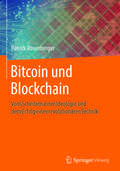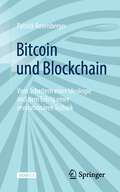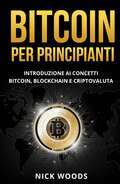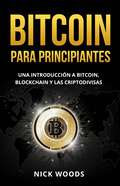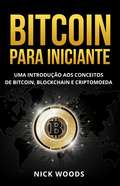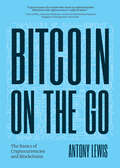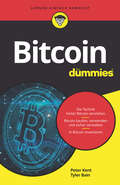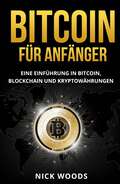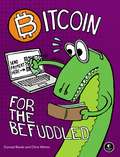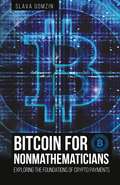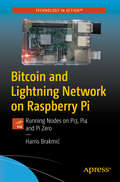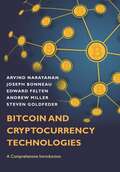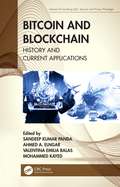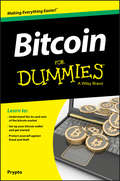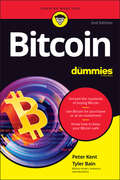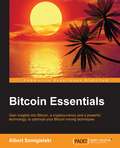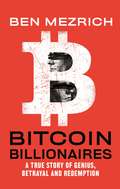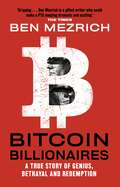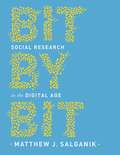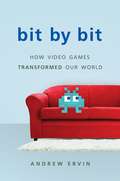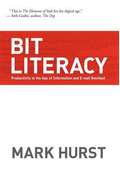- Table View
- List View
Bitcoin und Blockchain: Vom Scheitern einer Ideologie und dem Erfolg einer revolutionären Technik
by Patrick RosenbergerDie Einführung von Kryptowährungen und der Blockchain-Technologie stellt unsere Gesellschaft vor völlig neue Herausforderungen. Schon in naher Zukunft werden sämtliche Bestandteile unseres Lebens unter dem Einfluss eines dezentralen Netzwerks stehen. Banken, Unternehmen, sogar Regierungen setzen auf das Potenzial der dezentralen Datenspeicherung. Was aber sind Blockchain und Kryptowährungen und wie sind sie entstanden? Dieses Buch ist eine unverzichtbare Lektüre für alle, die ein tiefes Verständnis für dieses Thema entwickeln möchten, ohne sich dafür mit Formeln oder Programmcode auseinanderzusetzen.Zur Einführung beleuchtet der Autor die Geschichte des Geldes und zeigt, wie sich die Zukunftswährung Bitcoin dank der innovativen Blockchains entwickeln konnte. Der legendäre Erfinder der ersten Kryptowährung, Satoshi Nakamoto, bleibt zwar bis heute anonym, ist jedoch in der Währung, die er sogar mit seinem Namen geprägt hat, mittlerweile millionenschwer. Detailliert beschreibt der Autor die Ideologie hinter der Technologie und ihre zahlreichen Anwendungsmöglichkeiten. Neben den berühmten Bitcoins haben inzwischen auch viele weitere Kryptowährungen wie Ethereum entwickelt, die ebenfalls auf der Technologie der Blockchains basiert. Mit der fortschreitenden Evolution des Internets der Dinge ist noch lange kein Ende der Entwicklung in Sicht. Allerdings entstehen bereits die ersten Alternativen zur Blockchain-Technologie, namentlich in Form des IOTA-Netzwerkes, einer Technik, die seit 2015 entwickelt wird und aktuell in der Betaphase steckt.Mit diesen und vielen weiteren Aspekten liefert das Buch eine spannende Lektüre zu einem der Themen der Zukunft und vermittelt erfahrenen Informatikern, aber auch technikaffinen Laien ein umfassendes Grundlagenwissen über Kryptowährungen und ihre zugrundeliegenden Technologien.
Bitcoin und Blockchain: Vom Scheitern einer Ideologie und dem Erfolg einer revolutionären Technik
by Patrick RosenbergerDer Erfolg von Kryptowährungen und der Blockchain-Technologie stellt unsere Gesellschaft vor völlig neue Herausforderungen. Schon in naher Zukunft könnten sämtliche Bestandteile unseres Lebens unter dem Einfluss eines dezentralen Netzwerks stehen. Banken, Unternehmen, sogar Regierungen setzen auf das Potenzial der dezentralen Datenspeicherung. Mit der fortschreitenden Evolution des Internets der Dinge, dem Metaverse oder der Möglichkeit, Vermögenswerte zu tokenisieren, ist noch lange kein Ende der Entwicklung in Sicht. Dabei war die Idee und Ideologie hinter Bitcoin eigentlich eine ganz andere: Die digitale Währung wurde als ein alternatives Zahlungssystem erfunden, das ohne die Kontrolle von Banken funktioniert.Dieses Buch ist eine unverzichtbare Lektüre für alle, die ein tiefes Verständnis für dieses Thema entwickeln möchten, ohne sich dafür mit Formeln oder Programmcode auseinanderzusetzen.
Bitcoin per tutti
by Eric Morse F. RossiCapire le basi dei Bitcoin I bitcoin sono una valuta digitale rivoluzionaria che sta trasformando il denaro come lo conosciamo, ma capire come funzionano può essere difficoltoso per un utente medio. Ora non più! Questo libro mette da parte le complessità e insegna le basi dei Bitcoin in modo semplice e comprensibile. Non è un libro di testo, ma un manuale introduttivo non tecnico che risponde alle domande più comuni e importanti che gli utenti hanno sui bitcoin, senza usare tecnicismi e senza aver bisogno di conoscenze tecniche pregresse. In questo libro troverete le risposte a: Cosa sono i Bitcoin? Cos’hanno di speciale? Cosa è la Blockchain? Cos’è il Mining? Chi controlla i Bitcoin? I Bitcoin sono sicuri? I Bitcoin sono anonimi? Come posso usarli in sicurezza? Devo investirci? ...e molto altro! E non vi sentirete come se steste imparando un'altra lingua o studiando per una laurea in informatica! Prerequisiti: NESSUNO! Se avete comprato qualcosa online sapete tutto ciò che serve per capire questo libro e imparare le basi di Bitcoin.
Bitcoin per Principianti: Un’introduzione al Bitcoin, Blockchain e Criptovalute
by Nick WoodsState cercando di imparare come poter guadagnare dalla rivoluzione del Bitcoin? Avete sentito parlare di Bitcoin ultimamente e non riuscite a capire cosa sia? Vi chiedete come potete iniziare a investire in Bitcoin, ma siete esitanti nell'investire in qualcosa che non capite? Vorreste essere in grado di capire il Bitcoin, ma avete paura che sia troppo complesso e complicato? State cercando una risorsa che vi aiuti a capire il Bitcoin, in modo da poter iniziare a investire in criptovalute senza paura? Se questo è il vostro caso, allora continuate a leggere! Bitcoin è un'affascinante valuta decentralizzata della nuova era che è disponibile solo online e permette all'utente di essere anonimo. È una moneta digitale che può essere utilizzata da chiunque sia collegato a Internet ed è indipendente da qualsiasi regione. Potete conservare iBitcoin in un "portafoglio elettronico", proprio come mettete i vostri soldi nel vostro portafoglio o in una banca. Tutto questo è gestito elettronicamente e non c'è denaro fiat (carta) coinvolto. Capire Bitcoin vi aiuterà a raggiungere tutti i vostri obiettivi investendo nella criptovaluta, non importa quanto grandi o piccoli siano. Indipendentemente da chi siete e da cosa volete realizzare, la base del Bitcoin è la stessa per tutti. Questo libro vi aiuterà a capire tutto quello che dovete sapere su Bitcoin, Blockchain e criptovalute, compresi i benefici e le sfide della nuova tecnologia. Vi fornirò una guida passo dopo passo per raggiungere un livello superiore di comprensione in modo che voi possiate sentirvi a vostro agio nell'essere coinvolto con Bitcoin e altre criptovalute. Non c'è mai stato un libro così facile nel suo approccio e così efficace per capire Bitcoin da un livello principiante. All'interno di queste pagine, scoprirete: Cos'è Bitcoin in dettaglio Perché Bitcoin è importante Confronto di Bitcoin con le valute Fiat<br
Bitcoin para principiantes
by Emmanuel ClementsBITCOIN PARA PRINCIPIANTES: La guía completa para principiantes para aprender, entender y explorar el mundo de Bitcoin en 2019 - Entender el poder de la tecnología de criptocurrency. Bitcoin es una criptocurrency creada en 2009. Los mercados denominados "bolsas de monedas" permiten a la gente comprar o vender monedas con diferentes monedas. Bitcoin es una nueva moneda que fue creada en 2009 por un desconocido con el alias de Satoshi Nakamoto. Las transacciones se realizan sin intermediarios, es decir, sin bancos. Bitcoin se puede utilizar para reservar hoteles en Expedia, comprar muebles en Overstock y comprar juegos de Xbox. Pero gran parte del bombo se trata de enriquecerse con el comercio. El precio del bitcoin se disparó a miles en 2017.
Bitcoin para Principiantes: Una Introducción a Bitcoin, Blockchain y las Criptodivisas
by Nick WoodsBitcoin es una fascinante divisa descentralizada new-age que sólo está disponible en línea y permite al usuario permanecer casi anónimo. Es una moneda digital que puede ser usada por cualquiera con conexión a Internet y de manera independiente a la región. Se pueden almacenar Bitcoins en una "billetera electrónica" de manera similar a como se hace en una billetera física o en un banco. Todo esto se hace de manera electrónica y no hay dinero (papel) fiduciario involucrado. Este libro te ayudará a entender todo lo que necesitas sobre Bitcoin, blockchain y las criptodivisas, incluyendo los beneficios y retos de la nueva tecnología, y te proveeré con una guía paso a paso para alcanzar altos niveles de entendimiento para que te puedas sentir cómodo al involucrarte con Bitcoin y otras criptodivisas.
Bitcoin para Iniciantes: Uma Introdução aos Conceitos de Bitcoin, Blockchain e Criptomoeda
by Nick WoodsBitcoin para Iniciantes por Nick Woods Uma introdução aos conceitos de Bitcoin, Blockchain e Criptomoeda Bitcoin é uma fascinante moeda descenteralizada da nova era que só se encontra disponível online e permite que o usuário se mantenha um tanto quanto anônimo. É uma moeda digital que pode ser usada por qualquer pessoa conectada à Internet e é independente de qualquer região. Você mantém o Bitcoin em uma "carteira eletrônica", da mesma forma que coloca seu dinheiro na carteira de couro ou no banco. Tudo isso é operado eletronicamente e não há moeda fiat (papel) envolvida. Este livro irá ajudá-lo(a) a entender tudo o que você precisa saber sobre Bitcoin, Blockchain e Criptomoedas, incluindo os benefícios e desafios da nova tecnologia, e eu irei fornecer a você um guia passo a passo para alcançar um nível mais alto de compreensão para que possa se sentir confortável ao se envolver com o Bitcoin e outras criptomoedas.
Bitcoin on the Go: The Basics of Bitcoins and Blockchains
by Antony LewisA Condensed Guide to Understanding Bitcoin, Blockchains, and Cryptocurrency“One of the few credible books I suggest when people ask ‘where can I learn about bitcoin?’―Zennon Kapron, Managing Director, Kapronasia (Review of The Basics of Bitcoins and Blockchains)You’re an active, on-the-go person and need a condensed version of the Antony Lewis best-selling The Basics of Bitcoins and Blockchains? Now Bitcoin on the Go offers the same clear guide to this new currency and the revolutionary technology that powers it―just in a condensed format.Bitcoin, Ethereum, and other cryptocurrencies. Gain an understanding of a broad spectrum of Bitcoin topics including the history of Bitcoin, the Bitcoin blockchain, and Bitcoin buying, selling, and mining. Learn how payments are made, and how to put a value on cryptocurrencies and digital tokens.Blockchain technology. What exactly is a blockchain, how does it work, and why is it important? Bitcoin on the Go answers these questions and more. Learn about notable blockchain platforms, smart contracts, and other important facets of blockchains and their function in the changing cyber-economy.Things to know before buying cryptocurrencies. Find trustworthy and balanced insights into Bitcoin investing and investing in other cryptocurrencies. Discover the risks and mitigations, learn how to identify scams, and understand cryptocurrency exchanges, digital wallets, and regulations.Learn about:Blockchain technology and how it worksWorkings of the cryptocurrency marketEvolution and potential impacts of Bitcoin and blockchains on global businessesYou’ve read The Bitcoin Standard, Blockchain Bubble or Revolution, the full version of The Basics of Bitcoins and Blockchains by Antony Lewis, or The Only Cryptocurrency Investing Book You'll Ever Need but you want to understand this new currency in a quick easy-to-read format. Pick up a copy of Bitcoin on the Go.
Bitcoin für Dummies (Für Dummies)
by Peter Kent Tyler BainBitcoin bieten Ihnen neue Möglichkeiten, wie Sie Ihr Geld anlegen und grundlegende Transaktionen im Zahlungsverkehr durchführen können. Der erste Schritt in die Welt der Kryptowährungen kann jedoch verwirrend und einschüchternd sein. Dieses Buch ist Ihre Orientierungshilfe: Peter Kent und Tyler Bain erklären Ihnen die technischen Hintergründe und zeigen Ihnen, wie Sie Bitcoin kaufen, eine Wallet erstellen und mit Bitcoin bezahlen. Auà erdem erfahren Sie, was Sie bei der Investition in Bitcoin beachten müssen und wie Sie sich vor Betrügern schützen.
Bitcoin für Anfänger: Eine Einführung in Bitcoin, Blockchain und Kryptowährungen
by Nick WoodsMöchten Sie lernen, wie Sie von der Bitcoin-Revolution profitieren können? Haben Sie in letzter Zeit in den Nachrichten von Bitcoin gehört und können sich nicht vorstellen, was Bitcoin ist? Fragen Sie sich, wie Sie anfangen können, in Bitcoin zu investieren, verstehen aber nicht wirklich, was Bitcoin eigentlich genau ist, und zögern, in etwas zu investieren, das Sie nicht verstehen? Wünschen Sie sich, Sie könnten Bitcoin verstehen, haben aber Angst, dass das Thema zu komplex und zu kompliziert ist? Haben Sie nach einem Buch gesucht, das Ihnen hilft, Bitcoin zu verstehen, damit Sie ohne Angst in Kryptowährungen investieren können? Wenn das nach Ihnen klingt, dann haben Sie das richtige Buch gefunden! Bitcoin ist eine faszinierende dezentrale Währung, die nur online verfügbar ist und es dem Benutzer ermöglicht, relativ anonym zu sein. Es ist eine digitale Währung, die von jedem, der mit dem Internet verbunden ist, verwendet werden kann und unabhängig von der Region ist. Sie bewahren Bitcoin in einer elektronischen „Wallet“ auf, ähnlich wie Sie Ihr Geld in Ihrer Brieftasche haben oder in eine Bank einzahlen. Dies wird alles elektronisch betrieben und es ist kein Fiat-(Papier)geld beteiligt. Wenn Sie Bitcoin verstehen, wird Ihnen das helfen, mit der Kryptowährung alle Ihre Investitionsziele zu erreichen, egal wie groß oder klein die sind. Unabhängig davon, wer Sie sind und was Sie erreichen möchten, die Basis von Bitcoin ist für alle gleich. Dieses Buch wird Ihnen helfen, alles zu verstehen, was Sie über Bitcoin, Blockchain und Kryptowährungen wissen müssen, einschließlich der Vorteile und Herausforderungen der neuen Technologie. Es ist eine Schritt-für-Schritt-Anleitung, damit Sie ein besseres Verständnis für Bitcoin und andere Kryptowährungen bekommen. In diesem Buch werden Sie Folgendes lernen: Was genau Bitcoin ist Warum Bitcoin wichtig ist Vergleich vo
Bitcoin for the Befuddled
by Conrad Barski Chris WilmerUnless you’ve been living under a rock for the last couple of years, you’ve probably heard of Bitcoin—the game-changing digital currency used by millions worldwide.But Bitcoin isn't just another way to buy stuff. It’s an anonymous, revolutionary, cryptographically secure currency that functions without the oversight of a central authority or government. If you want to get into the Bitcoin game but find yourself a little confused, Bitcoin for the Befuddled may be just what you’re looking for. Learn what Bitcoin is; how it works; and how to acquire, store, and spend bitcoins safely and securely.You'll also learn:–Bitcoin’s underlying cryptographic principles, and how bitcoins are created–The history of Bitcoin and its potential impact on trade and commerce–All about the blockchain, the public ledger of Bitcoin transactions–How to choose a bitcoin wallet that’s safe and easy to use–How to accept bitcoins as payment in your physical store or on your website–Advanced topics, including Bitcoin mining and Bitcoin programmingWith its non-technical language and patient, step-by-step approach to this fascinating currency, Bitcoin for the Befuddled is your ticket to getting started with Bitcoin. Get out from under the rock and get in the Bitcoin game. Just make sure not to lose your shirt.
Bitcoin for Nonmathematicians: Exploring the Foundations of Crypto Payments
by Slava GomzinIt's thoughtless to start using something you don't trust. It's difficult to start trusting something you don't understand. Bitcoin for Nonmathematicians contains answers to the following questions: how bitcoin is different from other payment systems, and why we can trust cryptocurrencies. The book compares bitcoin with its predecessors and competitors, and demonstrates the benefits of cryptocurrency over any other existing methods of payments. Bitcoin for Nonmathematicians starts from overview of the evolution of payment systems from gold and paper money to payment cards to cryptocurrencies, and ends up with explaining the fundamentals of security and privacy of crypto payments by explaining the details of cryptography behind bitcoin in layman's terms.
Bitcoin et son pouvoir: Tout ce que vous devez savoir sur l’exploitation du pouvoir de Bitcoin
by Jerry RyderBitcoin prend le contrôle du MONDE. Cette monnaie numérique est complètement différente de tout ce que nous avons vu dans le passé, ce qui la rend nouvelle et passionnante : Cette monnaie présente également de nombreux avantages intéressants, tels que: La possibilité d'envoyer de l'argent partout dans le monde avec de faibles frais de transaction Garder vos informations personnelles en sécurité Ne pas avoir à faire face à l'intervention du gouvernement Il est maintenant temps d'entrer dans le jeu du bitcoin, de la crypto-monnaie et tout le monde sait que la connaissance est un pouvoir. Dans ce livre, vous apprendrez: Ce que Bitcoin est réellement. Toutes les différentes façons dont vous pouvez utiliser Bitcoin pour votre gain personnel Comment commencer La technologie derrière l'exécution de Bitcoin Ce que la monnaie numérique peut faire pour vous Avantages et inconvénients de l'utilisation des monnaies numériques Meilleures stratégies d'investissement Comment gagner de l'argent avec Bitcoin Et bien plus encore!
Bitcoin and Lightning Network on Raspberry Pi: Running Nodes on Pi3, Pi4 and Pi Zero
by Harris BrakmićCompile and run Bitcoin full nodes, lightning nodes, and user-friendly web-apps that help abstract the complexities of Bitcoin. This book not only explains the tools and techniques to help readers build their own banks and banking apps, but it also tells a story. Starting with the origins of Bitcoin—what it is and why we need it—find out what its strengths and limitations are. Understand the nature of mining and why so much energy is put into it. The blockchain itself will be reviewed, as well, and compared to other options such as a normal SQL database or a simple spreadsheet.With this book, you can control Bitcoin wallets via RPC commands on a Raspberry Pi. Configure, compile, and run two implementation of the Lightning Network-compatible daemons: LND and c-lightning. And employ user-friendly web apps that abstract the complexities of Bitcoin/Lightning-Network.The Internet of Information is currently transitioning to the Internet of Things, which in turn may well be followed by the Internet of Value (or Money). However, there is no evolution without happy users and Bitcoin will never reach the same heights like the original internet without having offered “useful” and “easy to use” tools. Just like nobody would ever want to use UUCP to send messages via web the same applies to current cryptocurrency tools. These are hard to use and very unforgiving. But, the evolution doesn’t stop here and many easy-to-use tools are already available. We will meet some of them when building apps for the Lightning Network, a new technology running on top of Bitcoin’s blockchain that makes it possible to generate billions of transactions within a single second. What You'll LearnControl Bitcoin wallets via console RPC commandsRun two implementation of the Lightning Network compatible daemonsSimplify the complexities of Bitcoin and the Lightning network with user-friendly web appsWho This Book Is ForThis book is for Makers familiar with the basics of Linux command line processes.
Bitcoin and Cryptocurrency Technologies: A Comprehensive Introduction
by Andrew Miller Edward Felten Arvind Narayanan Joseph Bonneau Steven GoldfederAn authoritative introduction to the exciting new technologies of digital moneyBitcoin and Cryptocurrency Technologies provides a comprehensive introduction to the revolutionary yet often misunderstood new technologies of digital currency. Whether you are a student, software developer, tech entrepreneur, or researcher in computer science, this authoritative and self-contained book tells you everything you need to know about the new global money for the Internet age.How do Bitcoin and its block chain actually work? How secure are your bitcoins? How anonymous are their users? Can cryptocurrencies be regulated? These are some of the many questions this book answers. It begins by tracing the history and development of Bitcoin and cryptocurrencies, and then gives the conceptual and practical foundations you need to engineer secure software that interacts with the Bitcoin network as well as to integrate ideas from Bitcoin into your own projects. Topics include decentralization, mining, the politics of Bitcoin, altcoins and the cryptocurrency ecosystem, the future of Bitcoin, and more.An essential introduction to the new technologies of digital currencyCovers the history and mechanics of Bitcoin and the block chain, security, decentralization, anonymity, politics and regulation, altcoins, and much moreFeatures an accompanying website that includes instructional videos for each chapter, homework problems, programming assignments, and lecture slidesAlso suitable for use with the authors' Coursera online courseElectronic solutions manual (available only to professors)
Bitcoin and Blockchain: History and Current Applications (Internet of Everything (IoE))
by Valentina Emilia Balas Sandeep Kumar Panda Ahmed A. Elngar Mohammed KayedIn recent years, blockchain development has grown quickly from the original Bitcoin protocol to the second-generation Ethereum platform, and to today’s process of building third-generation blockchains. During this evolution, we can see how blockchain technology has evolved from its original form as a distributed database to becoming a fully fledged, globally distributed, cloud computing platform. This book traces the past, present, and future of blockchain technology. Presents the knowledge and history of Bitcoin Offers blockchain applications Discusses developing working code for real-world blockchain applications Includes many real-life examples Covers the original Bitcoin protocol to the second-generation Ethereum platform Bitcoin and Blockchain: History and Current Applications is a useful reference for students, business schools, research scholars, practitioners, and business analytics professionals.
Bitcoin For Dummies
by Consumer Dummies Prypto<p><i>Bitcoin For Dummies</i> is the fast, easy way to start trading crypto currency, with clear explanations and expert advice for breaking into this exciting new market. Understanding the mechanisms and risk behind Bitcoin can be a challenge, but this book breaks it down into easy-to-understand language to give you a solid grasp of just where your money is going. You'll learn the details of Bitcoin trading, how to set up your Bitcoin wallet, and everything you need to get started right away. An in-depth discussion on security shows you how to protect yourself against some of the riskier aspects of this open-source platform, helping you reduce your risks in the market and use Bitcoin safely and effectively. <p>Bitcoin uses peer-to-peer technology to operate with no central authority or banks, with transaction management and issuing of Bitcoins carried out collectively by the network. Bitcoin allows easy mobile payments, fast international payments, low- or no-fee transactions, multi-signature capabilities, and more, but the nuances of the market can be difficult to grasp. This informative guide lays it all out in plain English, so you can strengthen your understanding and get started now. <p> <li>Understand the ins and outs of the Bitcoin market <li>Learn how to set up your Bitcoin wallet <li>Protect yourself against fraud and theft <li>Get started trading this exciting new currency</li> <p> <p>The Bitcoin market is huge, growing quickly, and packed with potential. There's also some risk, so you need to go in fully informed and take steps to manage your risk wisely. Bitcoin For Dummies is the clear, quick, easy-to-follow guide to getting started with Bitcoin.</p>
Bitcoin For Dummies
by Peter Kent Tyler BainA primer on the currency alternative that's changing the world Bitcoin can be a bit puzzling to the uninitiated. Ledger? Blockchain? Mining? These cryptocurrency concepts aren't going away, and there are tremendous opportunities for those with some know-how to get onboard with the crypto culture. Bitcoin For Dummies helps you get un-puzzled, learn the Bitcoin basics, and discover the possibilities in the new world of digital currencies. With this 100% new edition, you can step into the fascinating culture of cryptocurrency and learn how to use Bitcoin as a currency or an investment vehicle. A little bit of knowledge will go a long way, and you’ll be ready to sail smoothly ahead as the crypto tsunami advances. Demystify Bitcoin and learn how to buy and sell cryptocurrency Create a digital wallet and make everyday purchases using Bitcoin Discover the ins and outs of investing in Bitcoin and other up-and-coming cryptocurrencies Participate in the cutting-edge culture of crypto Bitcoin For Dummies is great for beginning Bitcoin users and investors who need to know the basics about getting started with Bitcoin and cryptocurrency.
Bitcoin Essentials
by Albert Szmigielski<p>Blockchain is being billed as the technology of the future. Bitcoin is the first application of that technology. Mining is what makes it all possible. Exploring mining from a practical perspective will help you make informed decisions about your mining setup. Understanding what the future may hold for blockchains, and therefore for mining, will help you position yourself to take advantage of the impending changes. <p>This practical guide starts with an introduction to Bitcoin wallets, as well as mining hardware and software. You will move on to learn about different mining techniques using the CPU, GPU, FPGA, and ultimately the ASIC as an example. After this, you will gain an insight into solo mining and pool mining, and see the differences between the two. The book will then walk you through large-scale mining and the challenges faced during such operations. Finally, you will take a look into the future to see a world where blockchain-based applications are commonplace and mining is ubiquitous.</p>
Bitcoin Billionaires: A True Story of Genius, Betrayal, and Redemption
by Ben MezrichFrom Ben Mezrich, the New York Times bestselling author of The Accidental Billionaires and Bringing Down the House, comes Bitcoin Billionaires--the fascinating story of brothers Tyler and Cameron Winklevoss's big bet on crypto-currency and its dazzling pay-off. Ben Mezrich's 2009 bestseller The Accidental Billionaires is the definitive account of Facebook's founding and the basis for the Academy Award–winning film The Social Network. Two of the story's iconic characters are Harvard students Tyler and Cameron Winklevoss: identical twins, Olympic rowers, and foils to Mark Zuckerberg. Bitcoin Billionaires is the story of the brothers’ redemption and revenge in the wake of their epic legal battle with Facebook. Planning to start careers as venture capitalists, the brothers quickly discover that no one will take their money after their fight with Zuckerberg. While nursing their wounds in Ibiza, they accidentally run into an eccentric character who tells them about a brand-new idea: cryptocurrency. Immersing themselves in what is then an obscure and sometimes sinister world, they begin to realize “crypto” is, in their own words, "either the next big thing or total bulls--t." There’s nothing left to do but make a bet. From the Silk Road to the halls of the Securities and Exchange Commission, Bitcoin Billionaires will take us on a wild and surprising ride while illuminating a tantalizing economic future. On November 26, 2017, the Winklevoss brothers became the first bitcoin billionaires. Here’s the story of how they got there—as only Ben Mezrich could tell it.
Bitcoin Billionaires: A True Story of Genius, Betrayal and Redemption
by Ben MezrichFrom Ben Mezrich, the New York Times bestselling author of The Accidental Billionaires and Bringing Down the House, comes Bitcoin Billionaires - the fascinating story of brothers Tyler and Cameron Winklevoss's big bet on crypto-currency and its dazzling pay-off.Ben Mezrich's 2009 bestseller The Accidental Billionaires is the definitive account of Facebook's founding - and the basis for the Academy Award-winning film The Social Network. Two of the story's iconic characters are Harvard students Tyler and Cameron Winklevoss: identical twins, Olympic rowers, and legal foils to Mark Zuckerberg. Bitcoin Billionaires is the story of the brothers' redemption and revenge in the wake of their epic legal battle with Facebook - and the first great book from the world of bitcoin.Planning to start careers as venture capitalists, the brothers quickly discover that no one will take their money for fear of alienating Zuckerberg. While nursing their wounds in Ibiza, they accidentally run into a shady character who tells them about a brand new idea: cryptocurrency. Immersing themselves in what is then an obscure and sometimes sinister world, they begin to realize "crypto" is, in their own words, "either the next big thing or total bulls--t." There's nothing left to do but make a bet.From the Silk Road to the halls of the Securities and Exchange Commission to the Facebook boardroom, Bitcoin Billionaires will take us on a wild and surprising ride while illuminating a tantalizing economic future. On November 26th, 2017, the Winklevoss brothers became the first bitcoin billionaires. Here's the story of how they got there - as only Ben Mezrich could tell it.
Bitcoin Billionaires: A True Story of Genius, Betrayal and Redemption
by Ben MezrichFrom Ben Mezrich, the New York Times bestselling author of The Accidental Billionaires and Bringing Down the House, comes Bitcoin Billionaires - the fascinating story of brothers Tyler and Cameron Winklevoss's big bet on crypto-currency and its dazzling pay-off.Ben Mezrich's 2009 bestseller The Accidental Billionaires is the definitive account of Facebook's founding - and the basis for the Academy Award-winning film The Social Network. Two of the story's iconic characters are Harvard students Tyler and Cameron Winklevoss: identical twins, Olympic rowers, and legal foils to Mark Zuckerberg. Bitcoin Billionaires is the story of the brothers' redemption and revenge in the wake of their epic legal battle with Facebook - and the first great book from the world of bitcoin.Planning to start careers as venture capitalists, the brothers quickly discover that no one will take their money for fear of alienating Zuckerberg. While nursing their wounds in Ibiza, they accidentally run into a shady character who tells them about a brand new idea: cryptocurrency. Immersing themselves in what is then an obscure and sometimes sinister world, they begin to realize "crypto" is, in their own words, "either the next big thing or total bulls--t." There's nothing left to do but make a bet.From the Silk Road to the halls of the Securities and Exchange Commission to the Facebook boardroom, Bitcoin Billionaires will take us on a wild and surprising ride while illuminating a tantalizing economic future. On November 26th, 2017, the Winklevoss brothers became the first bitcoin billionaires. Here's the story of how they got there - as only Ben Mezrich could tell it.
Bit by Bit: Social Research in the Digital Age
by Matthew J. SalganikAn innovative and accessible guide to doing social research in the digital ageIn just the past several years, we have witnessed the birth and rapid spread of social media, mobile phones, and numerous other digital marvels. In addition to changing how we live, these tools enable us to collect and process data about human behavior on a scale never before imaginable, offering entirely new approaches to core questions about social behavior. Bit by Bit is the key to unlocking these powerful methods—a landmark book that will fundamentally change how the next generation of social scientists and data scientists explores the world around us.Bit by Bit is the essential guide to mastering the key principles of doing social research in this fast-evolving digital age. In this comprehensive yet accessible book, Matthew Salganik explains how the digital revolution is transforming how social scientists observe behavior, ask questions, run experiments, and engage in mass collaborations. He provides a wealth of real-world examples throughout and also lays out a principles-based approach to handling ethical challenges.Bit by Bit is an invaluable resource for social scientists who want to harness the research potential of big data and a must-read for data scientists interested in applying the lessons of social science to tomorrow’s technologies.Illustrates important ideas with examples of outstanding researchCombines ideas from social science and data science in an accessible style and without jargonGoes beyond the analysis of “found” data to discuss the collection of “designed” data such as surveys, experiments, and mass collaborationFeatures an entire chapter on ethicsIncludes extensive suggestions for further reading and activities for the classroom or self-study
Bit by Bit: How Video Games Transformed Our World
by Andrew ErvinAn acclaimed novelist and critic argues that video games are the most vital art form of our timeVideo games have been around for decades, but only in recent years have they gone truly mainstream. Today, the majority of American households play video games, almost half of gamers are women, and professional video game tournaments attract more viewers than the World Series. Yet we still don't take games seriously, preferring to see them as little more than entertaining diversions, a means of making the commute go by a little more quickly.In Bit by Bit, a blend of history, memoir, and reportage, Andrew Ervin sets out to understand the explosive popularity of this often maligned cultural form. He travels to government laboratories, junk shops, and art museums. He scientists and hobbyists, critics and game makers. He installs a full-sized and obscenely loud Donkey Kong arcade cabinet in his basement, and plays enough Minecraft to suffer from "Minecraft syndrome," the effect of seeing objects in real life as poorly rendered blocks.In exploring the material, technological, and business history of video games, from Tennis for Two (1958) to Pokemon Go and beyond, Ervin shows how games constitute a unique storytelling medium that offers us startling new ways to think about our lives and the world around us. And he argues that the best games, as defined by the aesthetic and even political ambitions of their creators, rise to the level of art. In this witty, searching book, Ervin explains the immense power of games--and why their reign will be long.
Bit Literacy: Productivity in the Age of Information and E-mail Overload
by Mark HurstMore than a quick fix or another "how-to" guide, the book offers an entirely new way of attaining productivity that users at any level of expertise can put into action right away. This is "bit literacy," a method for working more productively in the digital age, with less stress.
